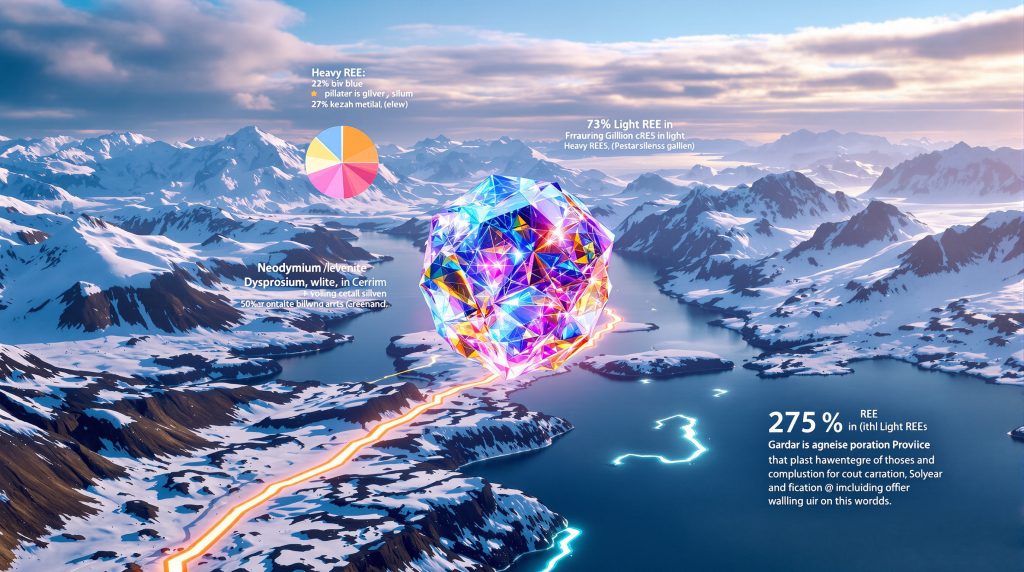Understanding the Strategic Importance of Greenland's REE Resources
Greenland has emerged as a critical frontier in the global rare earth element landscape, with Greenland's critical minerals positioning the Arctic territory as a cornerstone for future supply chain diversification. The Amaroq rare earth elements discovery South Greenland represents a significant development, as the territory contains approximately 20% of global REE reserves according to the European Commission's Joint Research Centre.
The confirmation of high-grade mineralisation by Amaroq Minerals at their Nunarsuit licence area represents a pivotal development within the established Gardar Igneous Province. This geological region has long attracted attention from exploration companies due to its favourable conditions for rare earth concentration, but recent surface sampling results have exceeded industry expectations for economically viable projects.
The Gardar Province's Geological Significance
The Gardar Igneous Province spans southern Greenland and represents one of the most geologically significant REE-bearing formations globally. This billion-year-old geological structure resulted from extensive alkaline magmatism, creating specialised geochemical environments that concentrated rare earth elements into economically attractive formations.
The province's alkaline magmatic history distinguishes it from many global REE deposits that occur in complex geological settings. Alkaline magmatic systems are characterised by magmas enriched in alkali elements relative to silica content, which preferentially fractionate rare earth elements into pegmatitic bodies and related mineral assemblages.
This process creates ideal exploration targets for high-grade REE mineralisation. Known REE deposits within the Gardar Province include:
• Kvanefjeld Project – A documented REE and uranium deposit
• Tanbreez Project – Another established REE occurrence
• Ilua Pegmatite Zone – Amaroq's newly confirmed discovery
The geological framework established by the Gardar Province provides the foundation for understanding why this region continues to yield significant rare earth discoveries. The billion-year-old alkaline magmatism created the necessary conditions for economic REE concentration.
How Does the Ilua Pegmatite Zone Compare to Global REE Standards?
Surface sampling at the Ilua Pegmatite Zone has revealed exceptional grades reaching 2.31% Total Rare Earth Oxide (TREO), substantially exceeding typical exploration benchmarks. Industry standards generally consider grades above 1% TREO as potentially economic, positioning this discovery well above the minimum threshold required for project viability.
The significance of these grades becomes apparent when compared to global REE deposit classifications. The 2.31% TREO represents grades more than double the minimum economic threshold, placing Ilua within the high-grade category of international rare earth projects.
This grade performance suggests the discovery warrants comprehensive evaluation for resource development potential. TREO represents the combined weight percentage of all rare earth element oxides present in mineralised material, providing a standardised measurement for comparison across deposits regardless of specific elemental composition.
Compositional Analysis and Market Value
The elemental composition of Ilua mineralisation demonstrates particularly favourable characteristics for current market demands. Amaroq's recent discovery indicates a distribution of 27% heavy REEs and 73% light REEs, with 21% comprising magnet-critical metals including neodymium, praseodymium, dysprosium, and terbium.
| REE Category | Percentage of Total | Key Elements |
|---|---|---|
| Light REEs | 73% | Neodymium, Cerium, Lanthanum |
| Heavy REEs | 27% | Dysprosium, Terbium, Yttrium |
| Magnet Metals | 21% | Neodymium, Praseodymium, Dysprosium, Terbium |
The 21% magnet metal composition positions this discovery favourably within current market dynamics driven by renewable energy and electric vehicle manufacturing. These elements represent the highest-value components of rare earth ore due to their essential roles in permanent magnet production for clean energy applications.
Neodymium and praseodymium serve as primary components of NdFeB permanent magnets, essential for electric vehicle motors and direct-drive wind turbines. Dysprosium and terbium function as critical dopants that enhance high-temperature performance in permanent magnets, with market values significantly higher than light rare earth elements.
What Processing Advantages Does This Discovery Offer?
The Amaroq rare earth elements discovery South Greenland demonstrates several processing advantages compared to many global REE deposits, particularly regarding uranium content and mineralogical characteristics. Assay results indicate uranium content below current government thresholds established by Greenland authorities, reducing regulatory complexity for potential processing operations.
The mineralisation appears hosted primarily within monazite mineralogy, which James Gilbertson, Exploration Vice President at Amaroq, described as representing well-understood rare earth ore mineral characteristics. These typically respond favourably to conventional extraction and processing techniques.
Simplified Extraction Methodology
Monazite-hosted REE mineralisation offers several operational advantages:
• Lower uranium content reduces regulatory classification requirements
• Conventional processing methodologies can be applied using established techniques
• Simplified waste management compared to uranium-bearing deposits
• Reduced environmental compliance complexity for processing operations
Monazite is a rare earth phosphate mineral with the general formula (Ce,La,Th)PO₄ that naturally concentrates light rare earth elements. The mineral's high density allows concentration via gravity separation and magnetic separation techniques, whilst established acid digestion methods effectively leach REE from monazite.
The conventional processing pathway for monazite includes physical concentration through gravity and magnetic separation. Furthermore, chemical processing using sulfuric acid or hydrochloric acid digestion follows, with standard solvent extraction and ion-exchange chromatography techniques then fractionating individual REE elements from the pregnant leach solution.
How Extensive Is the Mineralised System?
Initial geological mapping suggests the REE-bearing pegmatite system demonstrates significant scale potential, with outcrop measurements indicating several metres in width and extending approximately 5 kilometres along strike. This dimensional scale suggests potential for substantial resource development beyond initial sampling locations.
The geological team has identified multiple parallel structures in the area, indicating the discovery may represent only part of a larger mineralised system. This observation suggests comprehensive exploration during future field seasons could reveal additional REE-bearing zones within the broader geological framework.
Exploration Potential and Future Development
The extensive nature of the pegmatite system, combined with parallel structures identified through initial mapping, suggests significant exploration potential warranting systematic evaluation during the 2026 field season.
Planned development activities include:
• Spring 2026 – Scout drilling campaign to test volumetric potential
• 2026 Field Season – Systematic exploration of parallel structures
• Future Phases – Resource definition and feasibility assessments
The 5-kilometre strike length provides substantial exploration targets for future drilling programmes. In addition, the identification of parallel structures suggests the potential for multiple discrete zones of REE mineralisation within the broader Ilua area.
Amaroq's technical team plans to conduct a scout drilling campaign as early as spring 2026 to test the volumetric potential of the prospect, representing the next phase in systematic resource evaluation.
What Are the Strategic Implications for Critical Mineral Supply Chains?
This discovery occurs within the broader context of global efforts to diversify critical minerals energy transition pathways, particularly as nations seek alternatives to concentrated production in specific geographic regions. Greenland's political stability and established mining regulatory framework provide additional strategic value for international supply chain considerations.
The timing aligns with increasing global demand for REE-dependent technologies across multiple sectors, creating favourable market conditions for new discoveries. The Gardar Province's position within this global framework makes the Amaroq rare earth elements discovery South Greenland particularly relevant to international critical mineral strategies.
Geopolitical and Economic Context
Current market drivers supporting REE demand growth include:
• Electric vehicle battery production expansion across global automotive markets
• Renewable energy infrastructure development requiring permanent magnets for wind turbines
• Defence technology applications dependent on high-performance permanent magnets
• Consumer electronics manufacturing growth requiring rare earth elements
The discovery provides an additional source of critical minerals within a politically stable jurisdiction, supporting international efforts to reduce supply chain concentration risks. Furthermore, Greenland's established mining framework and regulatory environment offer advantages for potential development compared to regions with less developed mining governance structures.
How Does This Impact Amaroq's Corporate Strategy?
The REE discovery represents Amaroq's strategic diversification beyond its established gold and copper portfolio in Greenland, marking the company's first confirmed entry into the critical minerals sector. This expansion positions Amaroq within high-growth market segments whilst leveraging existing regional expertise and operational infrastructure.
James Gilbertson emphasised that this potential discovery builds on the company's expertise in resource definition and mine development within the region. However, it also diversifies into critical minerals during a period of rising global demand for these resources.
Portfolio Diversification Benefits
Amaroq's expanded Greenland asset portfolio now includes:
• Gold Projects – Nalunaq project (approved for development in July 2024)
• Copper Exploration – Various targets within established geological frameworks
• REE Development – Nunarsuit licence area with confirmed high-grade mineralisation
• Base Metal Exploration – Additional exploration licences across Greenland
The diversification strategy positions Amaroq to capitalise on multiple commodity cycles whilst maintaining focus within the Greenland jurisdiction. Consequently, the company has developed operational expertise and regulatory familiarity within this region.
What Challenges and Opportunities Lie Ahead?
Whilst the discovery presents significant potential, several factors will influence successful development from exploration through potential production. The combination of favourable geological conditions and challenging operating environment creates both opportunities and obstacles for project advancement.
Development Considerations
Key opportunities supporting development include:
• Established mining infrastructure in southern Greenland reducing capital requirements
• Favourable geological conditions for resource expansion and exploration success
• Growing global demand for critical minerals supporting market fundamentals
• Supportive regulatory environment with established mining governance frameworks
Primary challenges requiring management attention:
• Arctic operating conditions creating seasonal constraints on exploration and development
• Infrastructure development requirements for processing and transportation
• Market volatility in REE pricing affecting project economics
• Competition from established global producers with existing market positions
The seasonal constraints imposed by Arctic conditions require careful planning for exploration campaigns and potential development activities. For instance, the remote location necessitates comprehensive infrastructure planning for any future production scenarios.
How Does This Discovery Fit Within Global REE Market Dynamics?
The confirmation of high-grade REE mineralisation in Greenland contributes to ongoing international efforts to diversify global supply sources for critical minerals. Current market dynamics favour new discoveries that can provide alternative supply chains for strategic applications whilst reducing geographic concentration risks.
Industry projections indicate continued growth in REE demand, driven primarily by clean energy transition requirements and technological advancement across multiple sectors. New discoveries like Ilua provide essential supply diversity to meet expanding needs whilst supporting supply chain resilience objectives.
Market Position and Future Outlook
The discovery's 2.31% TREO grades and favourable elemental composition position it competitively within the global REE project pipeline. The 21% magnet metal content aligns with the highest-value market segments driving current demand growth, particularly in renewable energy and electric vehicle applications.
Furthermore, rare earth distribution insights demonstrate how this discovery fits within the broader global supply context. Expected near-term developments include:
• Additional assay results from the 2025 exploration campaign
• Detailed geological mapping of parallel structures identified in initial work
• Preliminary resource estimation following the planned 2026 drilling programme
The integration of the Amaroq rare earth elements discovery South Greenland within the broader Gardar Province geological framework suggests potential for additional REE discoveries as exploration continues across the region. The province's established position as a significant global REE resource base supports continued exploration investment and development interest.
However, the success of this discovery must be viewed within the context of European CRM supply strategies and broader mining industry innovation trends. These factors will ultimately determine how this discovery contributes to global critical mineral supply chains.
Additionally, detailed exploration updates provide ongoing insights into the development of this significant discovery.
Disclaimer: This analysis is based on publicly available information and exploration results as reported. Rare earth element projects involve significant geological, technical, and market risks. Future exploration results, resource estimates, and development timelines remain subject to numerous variables including geological conditions, market factors, and regulatory considerations. Readers should conduct independent research and consider professional advice before making investment decisions related to mining and exploration companies.
Interested in Capitalising on Critical Mineral Discoveries?
Discovery Alert's proprietary Discovery IQ model delivers real-time alerts on significant ASX mineral discoveries, instantly empowering subscribers to identify actionable opportunities ahead of the broader market. Begin your 30-day free trial today and secure your market-leading advantage.




